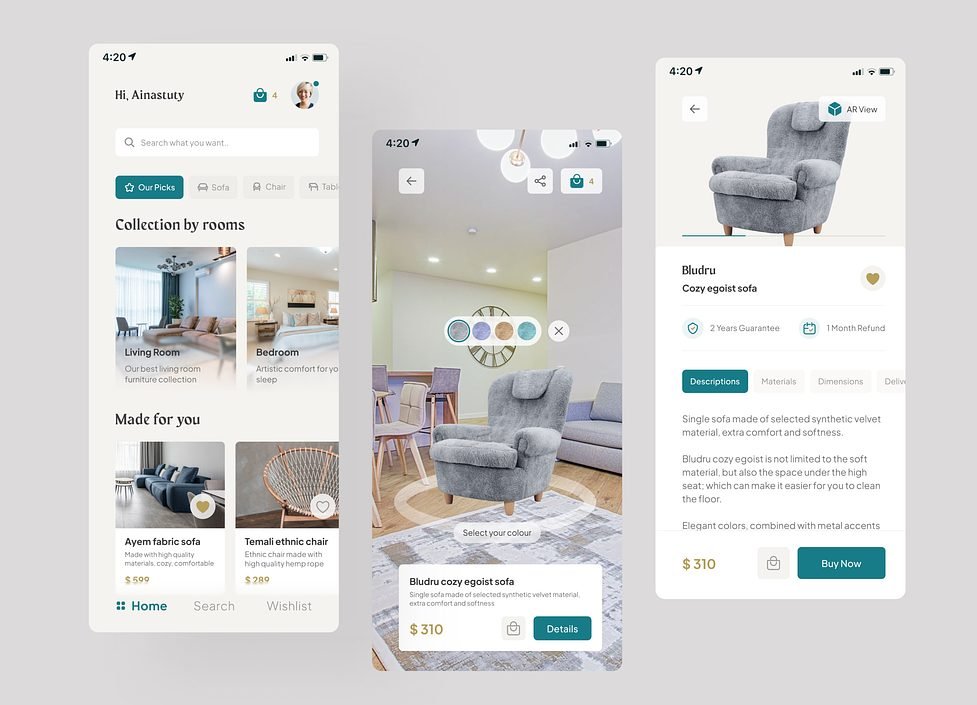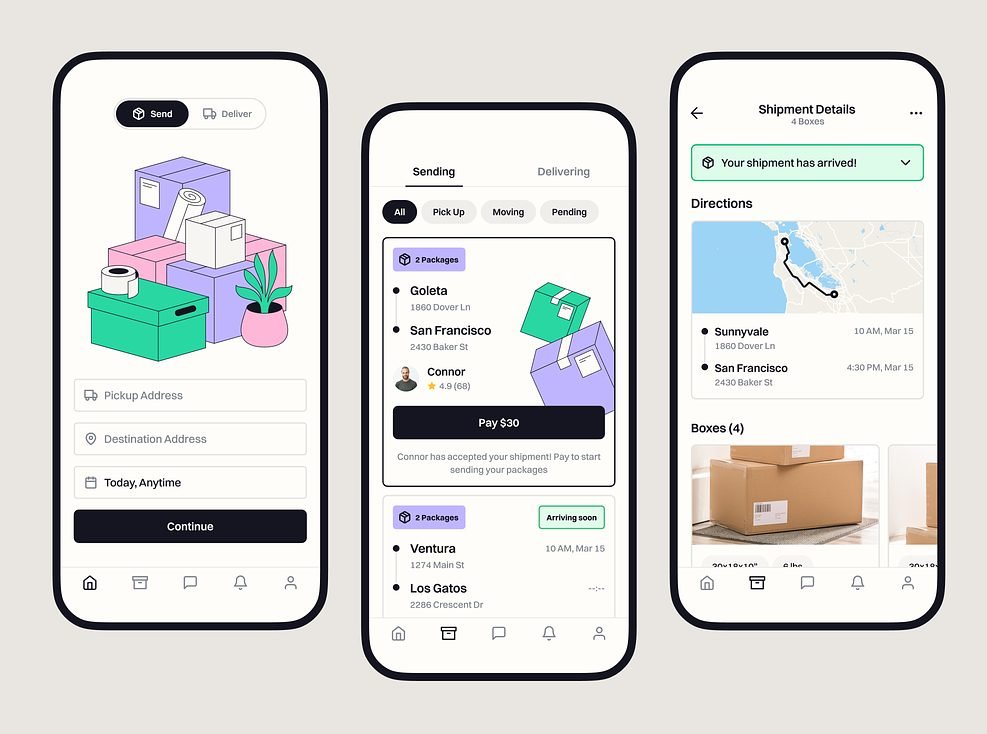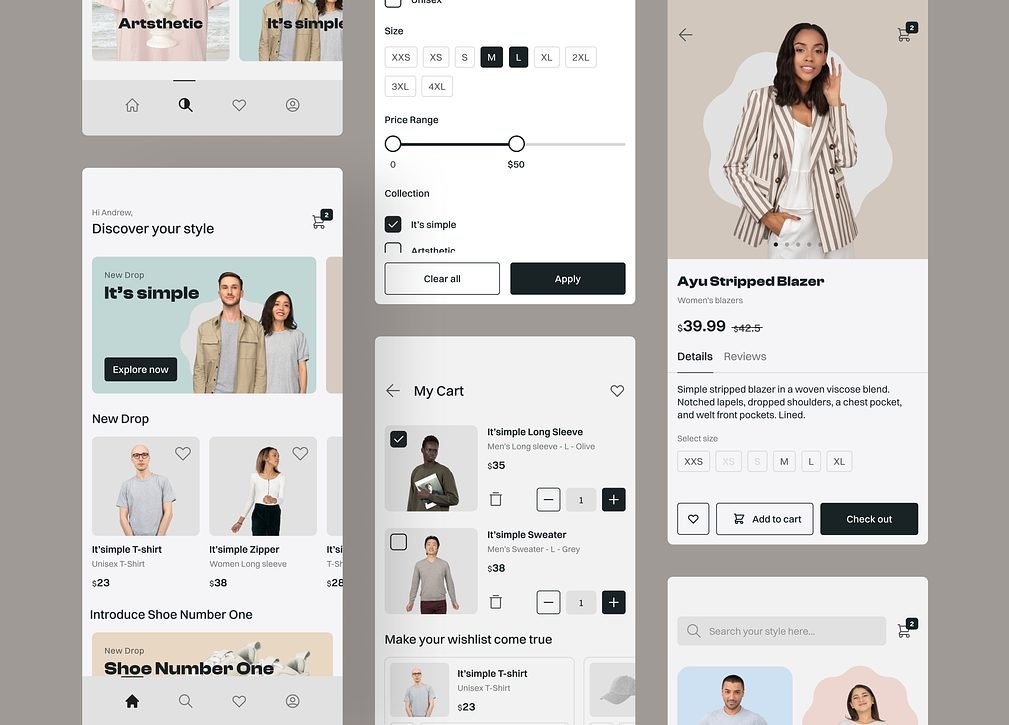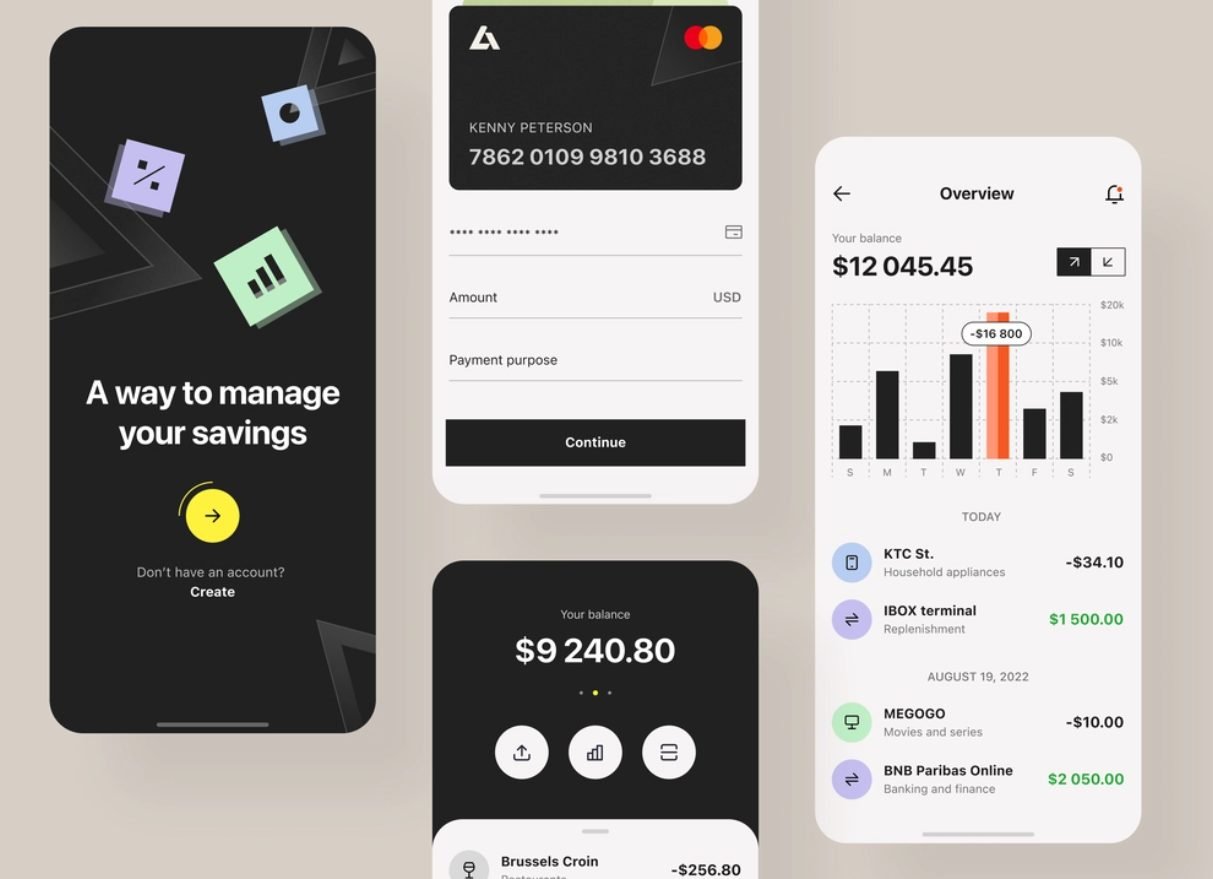Mobile sales are anticipated to exceed $3.56 trillion, which is a 22.3% increase over the previous couple of years, according to Statista. Assuming it operates in the eCommerce sector, this is a compelling argument for your business to consider developing a shopping app and launching a mobile shopping site that will outrun your competitors. We offer help with mvp development services and building a mobile shopping site and beyond.

Shopping App Market Trends and Major Players
There are many popular online shopping apps. While online shopping app development of your product, you might draw inspiration from their enormous popularity. A good mobile app combines excellent design with helpful functionality to improve corporate operations and foster stronger client relationships. Here’s the list of the industry leaders for Android shopping app or any other.
| Apps | Platforms | Functionality |
| Amazon | Both Android and iOS devices can use Amazon’s mobile app, which includes app-only advantages. The main objective was to make mobile shopping quicker and simpler than PC shopping. |
|
| AliExpress | Alibaba’s one of the most popular and widely used shopping apps is accessible on both Android and iOS. |
|
| eBay | Amazon’s main rival, eBay, is also situated in the United States. They produced mobile applications for iOS and Android. | App-exclusive sales
|
| Etsy | Etsy is an online store for people who want to sell their handcrafted or vintage goods, artwork, craft supplies, and other goods. Accessible on iOS and Android. |
|
| Snapdeal | For Android and iOS users, Snapdeal is one of the biggest and most well-liked online shopping apps in India. |
|
| Wish | Wish is a very affordable online store that sells items at low costs with protracted delivery times (similar to AliExpress), and it is accessible on Android and iOS. Because Wish connects buyers with manufacturers directly, the prices are low. |
|
The user experience is often what distinguishes good apps from bad. A quality app should provide the user with unique value and be user-friendly, responsive, consistent, secure, and reliable. A poor app, on the other hand, can be slow and buggy, have a perplexing user interface (UI), appear cluttered and busy, or simply fail to meet a business need.
Benefits of shopping app development
More people than ever before use mobile applications, yet the level of app competition is still at an all-time high. But how can you make an app that stands out in the over 2.5 million currently available apps? And what attributes to an app’s success?
If you own an e-commerce company and your online store don’t already have a mobile app, you’re losing out on a big market of clients that prefer mobile shopping. Whether you run an online store offering apparel, gadgets, cosmetics, or anything else, you can profit from a mobile app. So, here’s why mobile shopping app development will benefit your business and it’s worthy to make a shopping app asap:
Improved conversion
Mobile e-commerce applications have higher conversion rates than mobile websites do. Due to the ease and user-friendliness of those mobile apps, people may purchase something with just a few clicks. When a customer has a perfect experience, they are more likely to make a buy.
A few elements that can combine to make shopping simpler include wish lists, product filtering, and product sorting. Mobile apps can also save all of your personal information and payment details for rapid checkout. These features make customer shopping easier, which makes mobile e-commerce apps a more sensible option.
Implement split testing and testing in production during the development process if you want your mobile e-commerce app to have a high conversion rate. This will enable you to identify any problems with the user interface of your shopping app android, so you may address issues before they discourage potential users of your software.
Brand awareness
Users’ devices constantly contain mobile apps. As a result, consumers will always be reminded of your brand whenever they open their phone and be more likely to choose it out of convenience the next time they need to buy anything.
Because mobile applications are easier to use than logging in to a desktop computer, finding the website, and manually typing a review, customers are more likely to leave reviews on them. You may define your brand identity through reviews, broaden your internet presence, and attract new customers. However, more than having a mobile app for your company is required. The app must offer a flawless user experience and welcoming UI/UX designs to entice users to use your brand again. This calls for you to regularly test your mobile app with the general public to make sure it runs well and provides a pleasant user experience.
Increased customer loyalty
Mobile apps have a big impact on how people perceive your brand. With an excellent mobile app, customers may browse a brand’s product catalog and their shopping cart at any time. By doing this, you may connect with your clients and encourage them to use your mobile app repeatedly. What results from this over time? – Loyal clients.
Most individuals carry their iPhones around with them all day long. This implies that customers have many more chances to look around your store and buy something while lounging at home, on the bus, or waiting for their morning coffee to brew. They’re more inclined to use your app when it’s already downloaded to their phone.
Ensure your website is adequately optimized for mobile devices because clients spend most of their time on their phones. The same product information, testimonials from devoted customers, your contact information, and, if available, a live chat option or chatbot, should all be included. They will then be motivated to decide to make a purchase because they have all the information they require.
You’ll be able to impress customers, showcase the value of your brand, and keep them coming back for more by putting the correct customer loyalty and retention strategies into practice. Consider designing loyalty programs that grant members access to new merchandise or collections before anybody else. Additionally, you ought to tailor their buying experience; nevertheless, more on that in the following section.
Prsonalized shopping experience
Personalization is essential to developing lasting client relationships in today’s competitive business environment. Customers want brands to appeal to their human side; they don’t want to be viewed like numbers that go toward your overall revenue. This entails disseminating customized content that is created with their requirements in mind, not the needs of the entire audience.
Your e-commerce site must have mobile app functionality, but there are other steps in developing a customized shopping experience. Furthermore, you can learn vital details about your audience’s interactions with your brand and online business.
With the help of these information, you can tailor their shopping experience by making product recommendations based on their preferences and past purchases, sending them bespoke cart abandonment emails, creating tailored marketing campaigns, and more.
Greater effectiveness
Mobile applications make it easier for your customers to shop, but they also help your company and the people running it function more efficiently. Your sales will increase and the customer experience will be simplified with a highly optimized app that has powerful capabilities.
Additionally, a superb mobile app that has completed various sorts of software testing draws in more users, which results in more sales for your company. Push notifications, which continually loop your consumers back to your app due to an abandoned shopping cart or a new promotion, enable customers to make quicker purchase decisions, resulting in a more effective sales process.

Key features of the online shopping app
The features you require will depend on the main function of your app and your intended audience, which your app or business goals will influence. Every mobile app should include a user interface that is easy to use, consistent branding, data privacy, a search or navigation feature, and analytics, at the very least. Consider a few must-have online shopping app features to include in your e-commerce project.
Search
One of the must have aspects for developing an online shopping app is this. This characteristic is crucial and a fundamental component that gives clients using the app an engaging shopping experience, regardless of whether they are buying groceries, accessories, clothing, footwear, etc.
Push notifications
Customers benefit from a tailored experience thanks to push alerts. It is a highly potent feature for any apps that facilitate online buying. Use smart push notifications to inform your users about special offers, discounts, and fantastic deals.
Product delivery & tracking
Giving clients access to product monitoring and delivery estimates is always crucial. Make sure your clients can easily keep track of products. Customers may track their products in real time by incorporating the geolocation characteristic.
The cart history
This feature may not be all that crucial at first, but it isn’t. For customers, it simplifies and facilitates things. They can use this function to view the specifics of their prior orders and the services the app has to offer.
Referral tokens, prizes, and codes
This feature can significantly improve the sales of your online business. These prizes and referral vouchers greatly enhance the value of your company.
Online assistance
With this online assistance option, the creation of your online retail application is complete. Customers can ask questions and receive advice on the services and use of the application thanks to this feature, which also offers convenience and support.
Advanced Features of Shopping Apps
There are always some more advanced features to add to your project to improve the UX. Users seek apps that add real value to their lives, whether resolving problems, boosting productivity, or just organizing their data. Additionally, users need an app that is simple to use and offers a seamless user experience. Let’s consider some which can make a really good mobile app here.
Well-structured UI
Delivering a solid initial impression is essential to maintaining user engagement in mobile apps because of their high churn rate. This first impression usually begins with an entertaining and straightforward user interface (UI), an important quality to keep in mind while developing an app.
A well-designed UI takes into account both the app’s overall aesthetic and its functional requirements. Even if an app offers the user a lot of value, people will only take the time to become familiar with it if the UI is straightforward. Additionally, if it doesn’t seem good, people won’t stick around, making it harder to promote adoption across the board.
Fast load time
A good app must have a quick and responsive loading time since it improves user experiences, increases user retention, and increases conversion rates.
A decent mobile app should load in under two seconds and not more than five if possible. Users expect their apps to be stable, dependable, and quick; those that frequently crash or take too long to load will simply be deleted. Common causes of sluggish app performance include:
- massive source code
- an overloaded server
- a surplus of data
- the use of outmoded software
- improperly optimized encrypted connections
Consider employing a strong content delivery network (CDN), enabling browser caching, and compressing data (such as photos, videos, graphics, and audio content) to design a mobile app that is quick and responsive. Regular software updates and ongoing performance testing for bugs and faults are also crucial. By keeping apps current with operating systems, this reduces the likelihood of crashes, stuttering, glitches, and other app efficiency problems.
Robust data protection
Customers and the information about your company are at risk when there is a security breach since it exposes sensitive data to attackers, including names, users ages, home addresses, and even banking information, etc. A security breach can also cause a company to lose thousands of dollars in clean-up and recovery costs, in addition to suffering significant financial losses as a result of lost clients and a damaged reputation. Consider putting some security best practices into action.
Built-in integrations
It’s crucial that you can integrate all of your data when you establish an app and across some of the other platforms you use for your business. Because of this, the best mobile apps feature built-in integrations like live stream shopping, etc. which are essential to an app’s success. Features of connectivity aid in the synchronization of data required for greater consumer insights. Other connectivity capabilities, like as in-app messaging or customer service integration, can hasten the feedback process, enhance internal collaboration, iBeacon and assist teams in finding quicker solutions to business issues.
Top-notch user support
It’s critical that your mobile app offers the appropriate level of user assistance if you want to create one that employees are likely to use. The overall navigation and accessibility of an app play a significant role in its quality. A search bar, tooltips, some shortcuts, or navigation tabs are a few of the app features that may be included in the UI to make the app more user-friendly and facilitate adoption throughout the company.

What you should consider when developing a shopping app
Although there are a number of elements that must be taken into account when creating a mobile app, here we’ll focus on some of the most important ones.
Target Audience
There needs to be more than the best app idea to ensure success. If you don’t research your target market, one of the common mistakes you’ll make is putting your app incorrectly in the market.
These are the ones who will download your app in the end. Your primary priority should be to understand what they prefer and dislike. Because of this, you should conduct in-depth market research before developing an application with the help of our ecommerce app development services.
Platform
You must determine which mobile platform is best for your shopping app based on your target market. According to your study, you can discover that the majority of your target users prefer iOS, Android, or both, thus you’ll need to decide which platform to build your app on.
Business model
Business technology choice also matters. As a result, your shopping app needs to incorporate the most recent mobile technologies. Otherwise, there is a danger that your program would become obsolete very soon due to technological innovation, inappropriately chosen business model, etc.
Monetization model
Launching an app that cannot deliver any good and bring your profit is pointless. Making money from app users is the process of monetizing an app. Subscription model pre-paid or other – consider them carefully. This may also entail a variety of tactics, including as placing banner ads at the bottom of your app, using rewarded video adverts, and using integrated advertising techniques, etc. Consider these before you create your app.
Security
Mobile devices are personal data bases that are frequently the main targets of data breaches and privacy abuses. Because of this, many consumers are reluctant to use their mobile devices for purchasing. This provokes for creating a bug-free, totally protected from external branches mobile application. To make sure that your software is not vulnerable to cyberattacks, great caution should be taken. It must be constructed with solid architecture incorporating the most recent security patches.
Marketing
The creation of your mobile shopping app is the first step on the road to success. Until your app has a sizeable and robust consumer base devoted to your brand, it will not succeed. In order to rank higher, you must optimize your graphics and content for the App Store and Play Store. Mobile app marketing makes sure that potential consumers perceive your app as having a strong market presence.
How to create a shopping app step-by-step
How to make a shopping app wisely step by step and avoid many mistakes on initial stages of app development process is a question. Create store app with a great ecommerce web development company and you will have no headache.
Discovery
You can better understand what your competitors are missing out on and what you can add to your offering by performing inventory user and market research. You should investigate the specialized market for your app to learn more about your users and rivals. You can use the following tactics to understand better your users and the market: defining the target audience, doing competitor analysis, conducting SWOT analysis, setting pitch, and creating a business strategy.
Choose your tech stack
A tech stack is what’s called the collection of technologies used to create an application, including front-end and back-end tools, databases, frameworks, and programming languages that are to be included into your app development process.
Draft a PRD
Every member of your design team contributes to and consults the PRD during the development process. Your PRD must have the following essential components in order to get the best results: product specifics, goals, background information and assumptions, user stories, design and user interactions, and challenges to be solved.
Create a UX wireframe
A wireframe is just an outline of your mobile application’s design. The wireframe’s sole function is to visually depict the app’s functionality and layout. It can be made by designers using a digital wireframing tool, a piece of paper, a whiteboard, or a napkin together with the product owners and stakeholders at an early stage of app development. Considering the critical role wireframes play in defining functionality and layout, they are indispensable in the design process of an ecommerce app, ensuring efficient collaboration between designers, product owners, and stakeholders.
Develop an MVP app
You should consider developing the app MVP on one platform before you build a mobile shopping site because hiring a professional to do so will cost you tens of thousands of dollars. Developers may save a ton of time and effort by using frameworks like React Native or Flutter, which allow them to write a single code base to create a shopping app and export it to Objective C and Java.
Testing
Before releasing your apps, you must test them to make sure all of their features and functions work as intended. After completing all the aforementioned processes, you now have a completely operational app to test. You must test your app thoroughly at this stage to ensure that it is both functionally sound and aesthetically pleasing. While there are various ways to test your app, beta testing and user acceptance testing (UAT) are two of the last test phases when the customer certifies that the program satisfies their criteria.
However, by carrying out these two types of testing, you can get the last word from actual users before deciding on your final result. Additionally, you can get input from your team members. Simply accept their constructive comments and set them to work on making the last modifications to the finished product, just like a designer or developer would.
App release
Once your software has passed all of the testing, the time has finally come to release it. The iTunes App Store for iOS apps as well as the Google Play Store for Android apps are the two most popular app marketplaces for you to submit your app to. For Android apps, you can upload your app file to the Google Play store (as you did for your beta), and users will be able to download and use it right away. This is due to Android’s lack of a review requirement before app launch. But before they can be approved for release on the App Store, all iOS apps must pass official evaluations to ensure that they adhere to Apple’s developer criteria.
Online shopping app development cost
Shopping app development demands resources. The cost to produce simple apps with fundamental features, like a calculator or flashlight app, can range from $10,000 to $40,000 and beyond. Apps that are more complicated, like social media, supply chain opportunities or e-commerce ones, cost anywhere from $30,000 to $500,000 or more.
Shopping app development team structure
How big is a development team for an app? A project manager, one or more developers, a designer, and a quality assurance engineer or tester often make up an app development team structure. Additional sales jobs can be required, depending on the scope and complexity of the project.
A product manager will be necessary if you have never overseen the mobile development process yourself in order to avoid making a mistake that will cause the entire project to fail. For any project to properly build a mobile app, the team size should be between 4 and 10.
In case you hire a classic agile team, agile teams have a cross-functional & collaborative structure. Each team member will bring a very unique skillset to the table, but they all strive to achieve the same thing: timely delivery of deliverables that satisfy the customer. A cross-functional agile team works well together and communicates openly.
Conclusion
There is no one method that works for all mobile app development projects that will result in a successful app. But several important factors should make your app more user-friendly and practical, such as having a well-designed user interface (UI), quick loading times, solid data protection, first-rate user assistance, and built-in connectors.
An appealing app should have a consistent brand, an easy-to-use user interface, and well-structured information. This entails using uniform color schemes and design principles throughout your platform, removing features that don’t improve the app, and displaying content with an eye toward information hierarchy.
Furthermore, consider exploring the potential of white label mobile apps, which offer pre-built, customizable solutions that can significantly accelerate your development timeline and reduce costs. This option can be particularly advantageous if your app concept aligns well with an existing white label framework, allowing you to focus on branding and specific features tailored to your unique target audience.
How to create a shopping app? Easy, if you know what you do. Or hire someone who does. So those are the steps involved in creating an app, including the design, development, and release. Every single step in the process calls for highly particular, specialized knowledge and expertise. Based on my own experience, these processes are flexible but can serve as a general framework for creating your app most efficiently and finding users. Good luck.




















